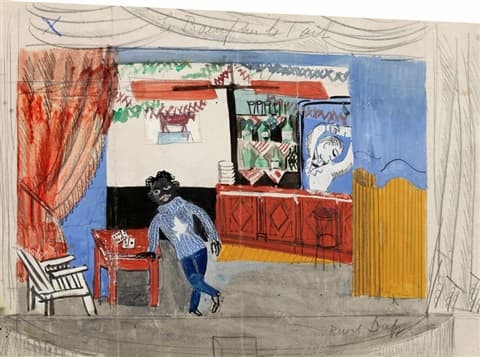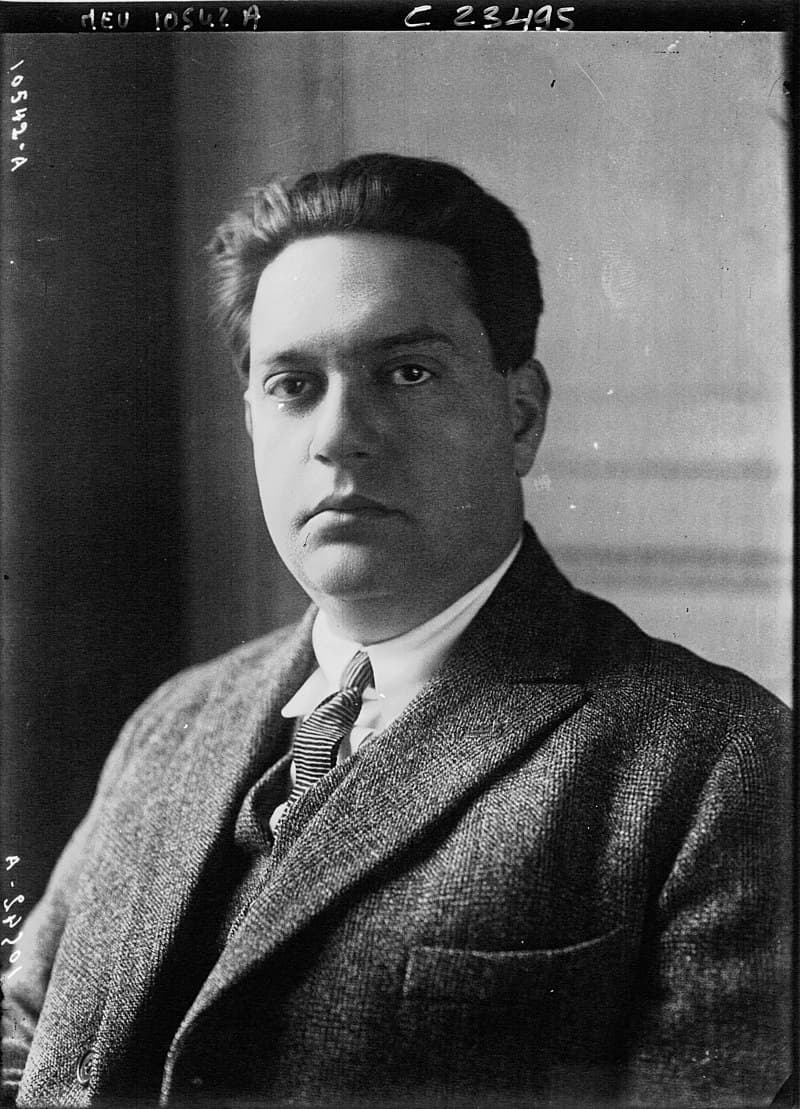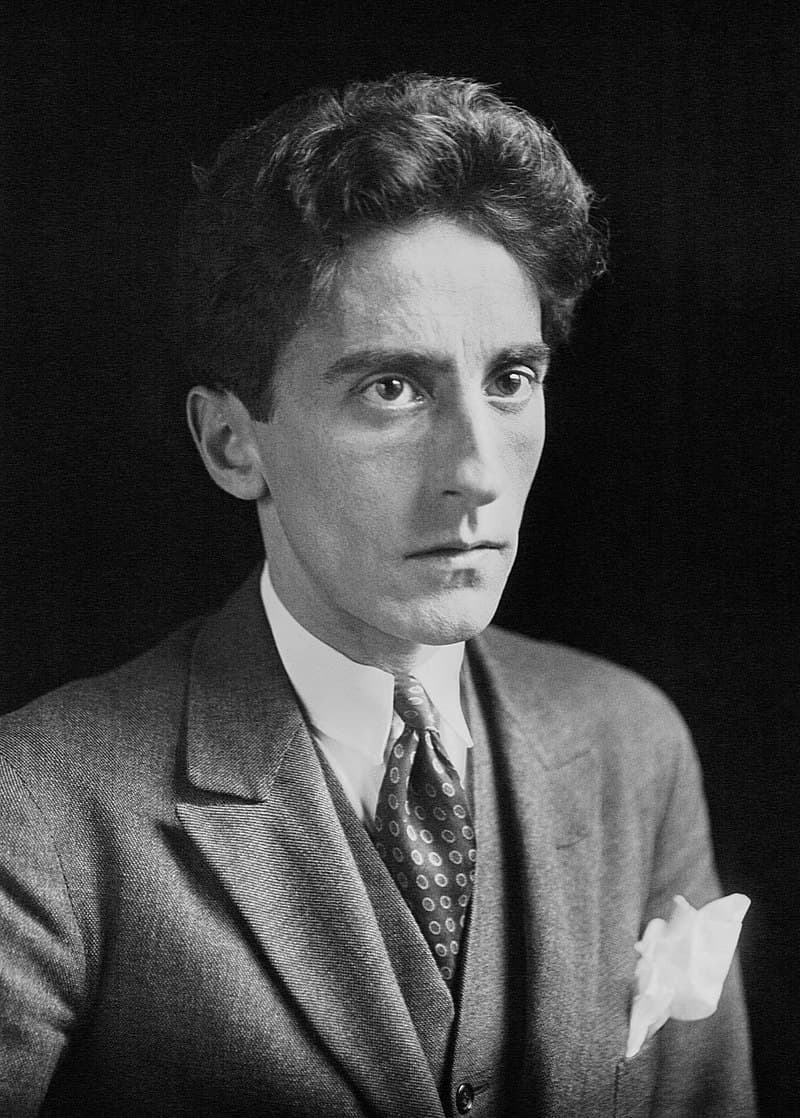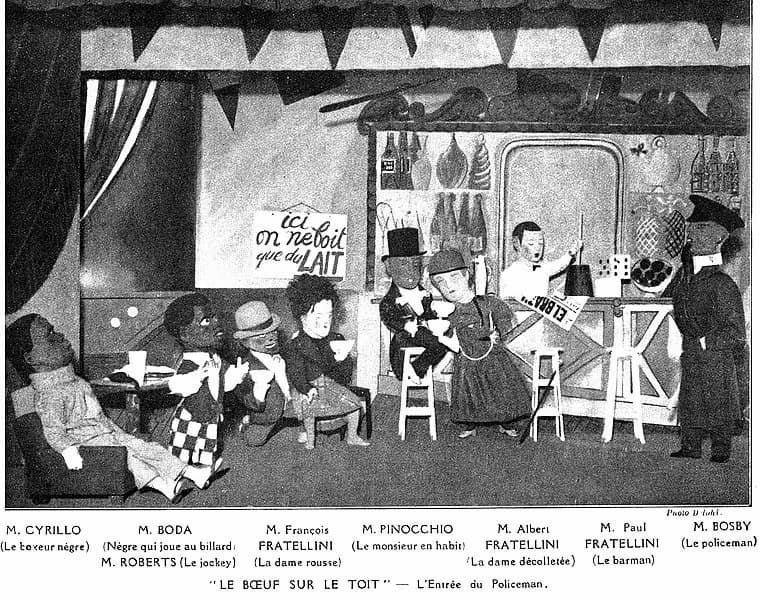By his mid-20s, Darius Milhaud (1892-1974) was already an international musical superstar. His musical direction was well established early on, as he writes, “My musical education was influenced exclusively by the Latin-Mediterranean cultural milieu, which is readily explained by the fact that I come from a very old Jewish family from the Provence.” Composing in a substantial diversity of styles and techniques, every sensual impression, it seems, was immediately encoded in musical terms. His approach paved the way for the musical eclecticism of the 20th century. “I have no aesthetic rules, or philosophy, or theories,” he explains, “I just love to write music.”

Le Boeuf sur le Toit, 1920 by Raoul Dufy
Milhaud absolutely loved the cinema and the new medium of film, and during his life, he would write music for 25 movies. It all started with his first major success, the 1919 Surrealist ballet “Le Boeuf sur le Toit,” (The Ox on the Roof). That work was originally subtitled a “Cinéma-symphonie,” and it featured fifteen minutes of music “rapid and gay, as a background to any Charlie Chaplin silent movie.”
Darius Milhaud: Le Bœuf sur le Toit, Part I (I Musici de Montréal)
The Ballet

Darius Milhaud, 1923
Charlie Chaplin had to wait as the French poet, novelist, dramatist, designer, boxing manager, playwright, and filmmaker Jean Cocteau persuaded Milhaud to let him use the music for a ballet. Cocteau was on a mission to eliminate foreign and specifically German elements from French music and culture, and the new ballet took its name from a popular Brazilian folksong. It became the location of Cocteau’s play, and subsequently, the name was attached to a celebrated Parisian cabaret bar “Le Bœuf sur le Toit,” which opened in 1921 and became a meeting place for Cocteau and his associates. The action on stage was described as “pleasantly devoid of all meaning,” and its characters include the Black Boxer, the Barman, the Jockey, the Black Billiard Player, the Red-Haired Lady, the Décolletée Lady, the Man in Evening Dress, and the Policeman. All characters wear enormous cardboard heads, and the boxer finds his cigar drawing badly and the barman cuts it for him with a pistol shot. The bullet strikes down the billiard player. The jockey takes exception to the boxer’s overtures to the red-headed lady and knocks him down, before joining the female customers in a tango.
The Plot and Characters

Jean Cocteau, 1923
A police whistle is heard; the barman hides all evidence of alcohol and disguises the room as a milk bar. A large policeman enters, smells the breath of the customers, and dances a genial solo. The barman presses a button: and an electric fan comes down from the ceiling and cuts off the policeman’s head. He falls dead, and one of the female customers dances with his severed head, in a parody of Salome. The barman replaces the head on the body of the policeman, who revives, but is confronted with a huge bill, several meters long, for everybody’s drinks. Despite the liveliness of the music, the characters dance in slow motion, “like deep-sea divers moving against the current.” The premiere took place on 21 February 1920 at the Comédie des Champs-Élysées as part of a program that also included Francis Poulenc‘s overture Cocardes, the ballet Adieu New York by Georges Auric, three settings by Poulenc of verses by Cocteau, and Trois petites pièces montées by Erik Satie. The production was a huge success, and Cocteau and Milhaud quickly took it to London where it ran under the title “The Nothing Doing Bar.”
Darius Milhaud: Le Bœuf sur le toit, Part II (I Musici de Montréal)
Milhaud and Brazilian Music

Cocteau’s 1920 production of Le Boeuf sur le Toit, décor by Raoul Dufy
Although composed in 1920, the music for Le Boeuf sur le Toit reaches back to Milhaud’s experiences with Brazilian music. Milhaud had spent almost two years in Brazil, as Embassy Secretary to Paul Claudel who was then heading the French diplomatic legation in Rio de Janeiro. Milhaud writes, “I was very much impressed by the great tropical forest and by the folklore, which is so rich.” Lively Brazilian melodies and rhythms are very prominent in this work, and Milhaud wrote, “I was intrigued and fascinated by the rhythms of this popular music… still haunted by the memories of Brazil, I assembled a few popular melodies, tangos, maxixes, sambas and even a Portuguese fado, and transcribed them with a rondo-like theme recurring between each successive pair.” A critic writes, “The spectacle presented yesterday was a considerable success. For the first time, the usual young and decrepit critics from the newspapers heard some young musicians in a theatre. Georges Auric, Francis Poulenc, Darius Milhaud: the names of the three young composers, who, although already known in their own circles, just yesterday burst violently in the very heart of Paris. Very successful caustic music!”
For more of the best in classical music, sign up to our E-Newsletter
Darius Milhaud: Le Boeuf sur le toit
